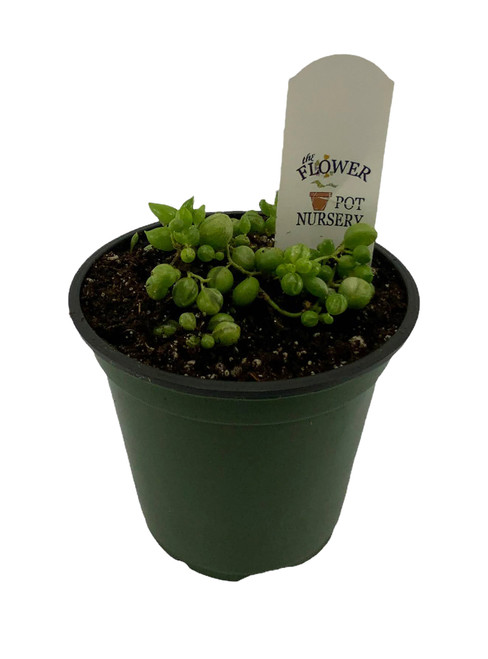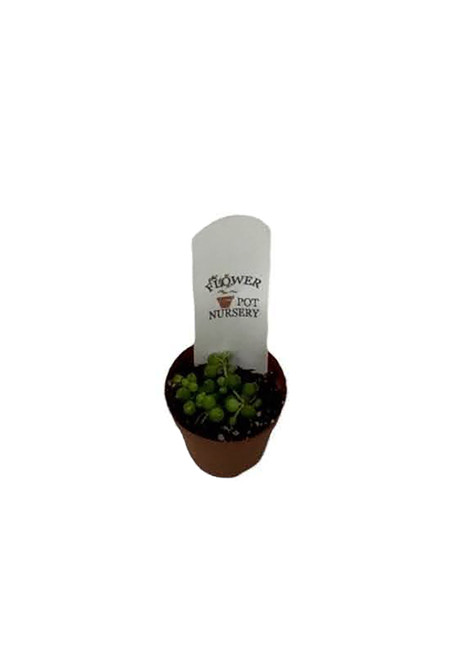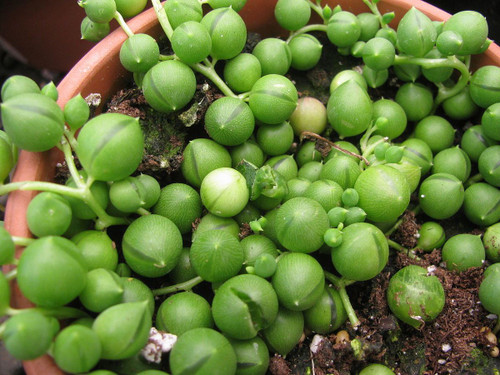Curio rowleyanus, syn. Senecio rowleyanus, is a flowering plant in the daisy family Asteraceae. It is a creeping, perennial, succulent vine native to the drier parts of southwest Africa. In its natural environment its stems trail on the ground, rooting where they touch and forming dense mats. It often avoids direct sunlight by growing in the shade of other plants and rocks. It is commonly known as string-of-pearls or string-of-beads.
"String-of-beads" and several other common names are shared with Curio herreanus (string of watermelons), which has teardrop-shaped leaves, rather than spherical.
This plant was named after British botanist Gordon Douglas Rowley who specialized in Cactaceae and succulents.
According to NCBI, Senecio rowleyanus is a synonym of Curio rowleyanus. However, IPNI and the Catalogue of Life 2000 maintain S. rowleyanus as an accepted name.
Curio rowleyanus receives its common name from specialized leaves which are the size and shape of small peas (about 1⁄4 inch diameter).Its trailing stems can grow 2-3 feet. There is a small tip at the distal point of each leaf and a thin band of dark green tissue on the side known as a "window" (see below). It blooms during the summer and, like all asterids, it has a compound flower. The trumpet shaped flower forms clusters (about 1⁄2 inch diameter) of small white flowers with colorful stamens. The flower will last about a month and is said to smell like cinnamon and other spices.
The odd shape of the leaves is an adaptation to arid environments and allows for the storage of water while exposing a minimum amount of surface area per volume to the dry desert air. This greatly reduces water loss due to evaporation relative to the typical dorsi-ventrally flattened leaves of most angiosperms. Although its spherical leaf morphology contributes to minimizing water loss, it also dramatically reduces the area available for the absorption of light and could be potentially detrimental to the plant's rate of photosynthetic carbon assimilation.
An adaptation that may help compensate for this reduction in light interception is a narrow, translucent, crescent-shaped band of tissue on the adaxial side of the lamina. This specialized structure is known as an "epidermal window" and it allows light to enter and irradiate the interior of the leaf, effectively increasing the area of leaf tissue available for photosynthesis. This is a trait shared with Curio radicans (string of bananas), a close relative of Curio rowleyanus. A similar morphology is observed in species of the genus Fenestraria as well as the species Haworthia cooperi and Frithia pulchra, which grow underground and only expose their leaf tips to absorb light radiation.
Give credit where credit is due: Wikipedia 2021
FlowerPotNursery String of Pearls Senecio rowleyanus 6" Basket
The Flower Pot Nursery
$25.99
- SKU:
- SPSR6B1221














